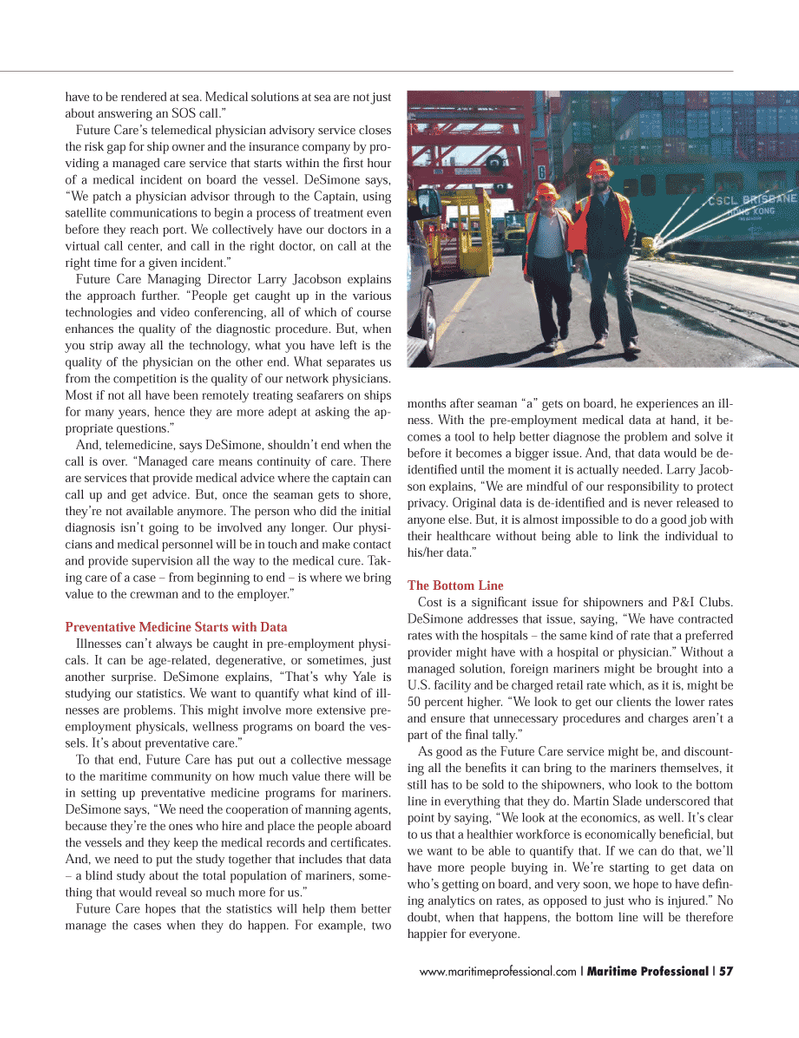
Page 57: of Maritime Logistics Professional Magazine (Q1 2014)
The Energy Edition: Exploration, Production & Transportation
Read this page in Pdf, Flash or Html5 edition of Q1 2014 Maritime Logistics Professional Magazine
have to be rendered at sea. Medical solutions at sea are not just about answering an SOS call.”
Future Care’s telemedical physician advisory service closes the risk gap for ship owner and the insurance company by pro- viding a managed care service that starts within the fi rst hour of a medical incident on board the vessel. DeSimone says, “We patch a physician advisor through to the Captain, using satellite communications to begin a process of treatment even before they reach port. We collectively have our doctors in a virtual call center, and call in the right doctor, on call at the right time for a given incident.”
Future Care Managing Director Larry Jacobson explains the approach further. “People get caught up in the various technologies and video conferencing, all of which of course enhances the quality of the diagnostic procedure. But, when you strip away all the technology, what you have left is the quality of the physician on the other end. What separates us from the competition is the quality of our network physicians.
Most if not all have been remotely treating seafarers on ships for many years, hence they are more adept at asking the ap- propriate questions.”
And, telemedicine, says DeSimone, shouldn’t end when the call is over. “Managed care means continuity of care. There are services that provide medical advice where the captain can call up and get advice. But, once the seaman gets to shore, they’re not available anymore. The person who did the initial diagnosis isn’t going to be involved any longer. Our physi- cians and medical personnel will be in touch and make contact and provide supervision all the way to the medical cure. Tak- ing care of a case – from beginning to end – is where we bring value to the crewman and to the employer.”
Preventative Medicine Starts with Data
Illnesses can’t always be caught in pre-employment physi- cals. It can be age-related, degenerative, or sometimes, just another surprise. DeSimone explains, “That’s why Yale is studying our statistics. We want to quantify what kind of ill- nesses are problems. This might involve more extensive pre- employment physicals, wellness programs on board the ves- sels. It’s about preventative care.”
To that end, Future Care has put out a collective message to the maritime community on how much value there will be in setting up preventative medicine programs for mariners.
DeSimone says, “We need the cooperation of manning agents, because they’re the ones who hire and place the people aboard the vessels and they keep the medical records and certifi cates.
And, we need to put the study together that includes that data – a blind study about the total population of mariners, some- thing that would reveal so much more for us.”
Future Care hopes that the statistics will help them better manage the cases when they do happen. For example, two months after seaman “a” gets on board, he experiences an ill- ness. With the pre-employment medical data at hand, it be- comes a tool to help better diagnose the problem and solve it before it becomes a bigger issue. And, that data would be de- identifi ed until the moment it is actually needed. Larry Jacob- son explains, “We are mindful of our responsibility to protect privacy. Original data is de-identifi ed and is never released to anyone else. But, it is almost impossible to do a good job with their healthcare without being able to link the individual to his/her data.”
The Bottom Line
Cost is a signifi cant issue for shipowners and P&I Clubs.
DeSimone addresses that issue, saying, “We have contracted rates with the hospitals – the same kind of rate that a preferred provider might have with a hospital or physician.” Without a managed solution, foreign mariners might be brought into a
U.S. facility and be charged retail rate which, as it is, might be 50 percent higher. “We look to get our clients the lower rates and ensure that unnecessary procedures and charges aren’t a part of the fi nal tally.”
As good as the Future Care service might be, and discount- ing all the benefi ts it can bring to the mariners themselves, it still has to be sold to the shipowners, who look to the bottom line in everything that they do. Martin Slade underscored that point by saying, “We look at the economics, as well. It’s clear to us that a healthier workforce is economically benefi cial, but we want to be able to quantify that. If we can do that, we’ll have more people buying in. We’re starting to get data on who’s getting on board, and very soon, we hope to have defi n- ing analytics on rates, as opposed to just who is injured.” No doubt, when that happens, the bottom line will be therefore happier for everyone. www.maritimeprofessional.com | Maritime Professional | 57
MP Q1 2014 50-63.indd 57 2/26/2014 1:34:57 PM

 56
56

 58
58
